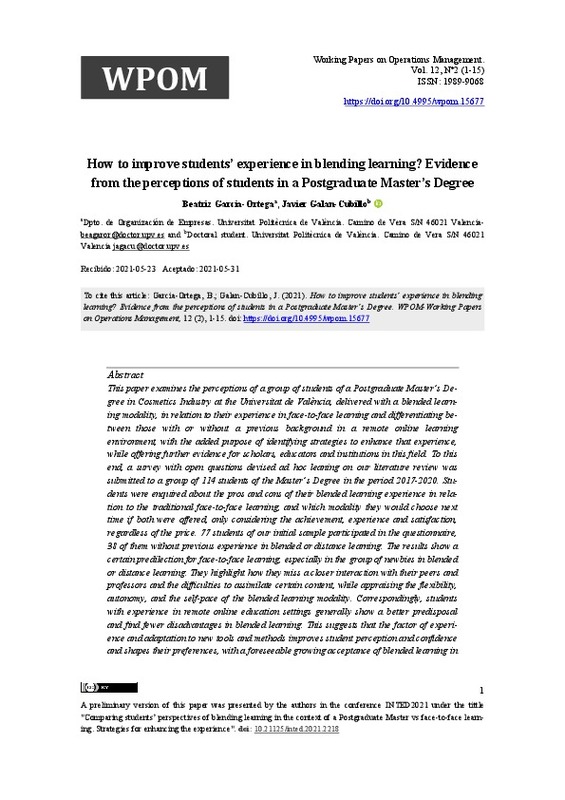Al-Khanjari, Z. A. S. (2018). Applying online learning in software engineering education. In Computer Systems and Software Engineering: Concepts, Methodologies, Tools, and Applications (pp. 217-231). IGI Global. https://doi.org/10.4018/978-1-5225-3923-0.ch010
Angeli, C., Valanides, N., & Bonk, C. J. (2003). Communication in a web‐based conferencing system: the quality of computer‐mediated interactions. British Journal of Educational Technology, 34(1), 31-43. https://doi.org/10.1111/1467-8535.00302
Arroyo-Barrigüete, J. L., López-Sánchez, J. I., Minguela-Rata, B., & Rodriguez-Duarte, A. (2019). Use patterns of educational videos: a quantitative study among university students. WPOM-Working Papers on Operations Management, 10(2), 1-19. https://doi.org/10.4995/wpom.v10i2.12625
[+]
Al-Khanjari, Z. A. S. (2018). Applying online learning in software engineering education. In Computer Systems and Software Engineering: Concepts, Methodologies, Tools, and Applications (pp. 217-231). IGI Global. https://doi.org/10.4018/978-1-5225-3923-0.ch010
Angeli, C., Valanides, N., & Bonk, C. J. (2003). Communication in a web‐based conferencing system: the quality of computer‐mediated interactions. British Journal of Educational Technology, 34(1), 31-43. https://doi.org/10.1111/1467-8535.00302
Arroyo-Barrigüete, J. L., López-Sánchez, J. I., Minguela-Rata, B., & Rodriguez-Duarte, A. (2019). Use patterns of educational videos: a quantitative study among university students. WPOM-Working Papers on Operations Management, 10(2), 1-19. https://doi.org/10.4995/wpom.v10i2.12625
Bonk, C. J., & Graham, C. R. (2012). The handbook of blended learning: Global perspectives, local designs. John Wiley & Sons.
Clark, T., & Barbour, M. K. (2015). Online, Blended, and Distance Education: Building Successful School Programs.
Dhawan, S. (2020). Online learning: A panacea in the time of COVID-19 crisis. Journal of Educational Technology Systems, 49(1), 5-22. https://doi.org/10.1177/0047239520934018
Garcia-Ortega, B., & Galan-Cubillo, J., (2021). Combining teamwork, coaching and mentoring as an innovative mix for self-aware and motivational learning. Imlementation case in teamwork sessions in the context of practices in a bachelor's degree. 15th Annual International Technology, Educationa and Development Conference. Valencia. Spain. https://doi.org/10.21125/inted.2021.2219
Garrison, D. R., & Vaughan, N. D. (2008). Blended learning in higher education: Framework, principles, and guidelines. John Wiley & Sons. https://doi.org/10.1002/9781118269558
Ginns, P., & Ellis, R. A. (2009). Evaluating the quality of e‐learning at the degree level in the student experience of blended learning. British Journal of Educational Technology, 40(4), 652-663. https://doi.org/10.1111/j.1467-8535.2008.00861.x
Gómez, W. A. R. (2014). Preguntas abiertas en encuestas ¿cómo realizar su análisis?. Comunicaciones en estadística, 7(2). https://doi.org/10.15332/s2027-3355.2014.0002.02
Grasso, L. (2006). Encuestas. Elementos para su diseño y análisis. Editorial Brujas.
Gros, B., & García-Peñalvo, F. J. (2016). Future trends in the design strategies and technological affordances of e-learning. Springer. https://doi.org/10.1007/978-3-319-17727-4_67-1
Halverson, L. R., & Graham, C. R. (2019). Learner engagement in blended learning environments: A conceptual framework. Online Learning, 23(2), 145-178. https://doi.org/10.24059/olj.v23i2.1481
Hong, J. C., Tai, K. H., Hwang, M. Y., Kuo, Y. C., & Chen, J. S. (2017). Internet cognitive failure relevant to users' satisfaction with content and interface design to reflect continuance intention to use a government e-learning system. Computers in Human Behavior, 66, 353-362. https://doi.org/10.1016/j.chb.2016.08.044
López-Pérez, M. V., Pérez-López, M. C., & Rodríguez-Ariza, L. (2011). Blended learning in higher education: Students' perceptions and their relation to outcomes. Computers & education, 56(3), 818-826. https://doi.org/10.1016/j.compedu.2010.10.023
Means, B., Toyama, Y., Murphy, R., & Baki, M. (2013). The effectiveness of online and blended learning: A meta-analysis of the empirical literature. Teachers College Record, 115(3), 1-47. https://doi.org/10.1177/016146811311500307
McGEE, E., & Poojary, P. (2020). Exploring Blended Learning Relationships in Higher Education Using a Systems-based Framework. Turkish Online Journal of Distance Education, 21(4), 1-13. https://doi.org/10.17718/tojde.803343
Kemp, N. (2020). University students' perceived effort and learning in face-to-face and online classes. Journal of Applied Learning and Teaching, 3(1), 69-77. https://doi.org/10.37074/jalt.2020.3.s1.14
Krause, K. (2007) "Griffith University blended learning strategy," Document number2008/0016252, 2007.
Norberg, A., Dziuban, C. D., & Moskal, P. D. (2011). A time‐based blended learning model. On the Horizon. https://doi.org/10.1108/10748121111163913
Poon, J. (2013). Blended learning: An institutional approach for enhancing students' learning experiences. Journal of online learning and teaching, 9(2), 271-288.
Rafiola, R., Setyosari, P., Radjah, C., & Ramli, M. (2020). The Effect of Learning Motivation, Self-Efficacy, and Blended Learning on Students' Achievement in The Industrial Revolution 4.0. International Journal of Emerging Technologies in Learning (iJET), 15(8), 71-82. https://doi.org/10.3991/ijet.v15i08.12525
Rovai, A. P., & Downey, J. R. (2010). Why some distance education programs fail while others succeed in a global environment. The Internet and Higher Education, 13(3), 141-147. https://doi.org/10.1016/j.iheduc.2009.07.001
Rovai, A. P., & Jordan, H. M. (2004). Blended learning and sense of community: A comparative analysis with traditional and fully online graduate courses. International Review of Research in Open and Distributed Learning, 5(2), 1-13. https://doi.org/10.19173/irrodl.v5i2.192
Sayed, M. (2013). Blended learning environments: The effectiveness in developing concepts and thinking skills. Journal of Education and Practice, 4(25), 12-17.
Stein, J., & Graham, C. R. (2020). Essentials for blended learning: A standards-based guide. Routledge. https://doi.org/10.4324/9781351043991
Tang, C. M., & Chaw, L. Y. (2016). Digital Literacy: A Prerequisite for Effective Learning in a Blended Learning Environment?. Electronic Journal of E-learning, 14(1), 54-65.
Tseng, H., & Walsh, E. J. (2016). Blended vs. traditional course delivery: Comparing students' motivation, learning outcomes, and preferences. Quarterly Review of Distance Education, 17(1), 1-21.
Volery, Thierry, and Deborah Lord. "Critical success factors in online education." International journal of educational management (2000). https://doi.org/10.1108/09513540010344731
Woo, Y., & Reeves, T. C. (2007). Meaningful interaction in web-based learning: A social constructivist interpretation. The Internet and higher education, 10(1), 15-25. https://doi.org/10.1016/j.iheduc.2006.10.005
Zhu, Y., Au, W., & Yates, G. (2016). University students' self-control and self-regulated learning in a blended course. Internet and Higher Education, 30, 54-62. https://doi.org/10.1016/j.iheduc.2016.04.001
[-]









